Economics for Managers: Market Structures, Banking, and Housing Crisis
VerifiedAdded on 2020/05/28
|23
|4137
|50
Report
AI Summary
This report provides an in-depth analysis of economic concepts relevant to managers. It begins by comparing and contrasting perfect and monopolistic competition, outlining their key features, equilibrium conditions, and efficiencies. The report then shifts focus to the oligopoly market structure, using the Australian banking industry as a case study to illustrate its characteristics. Finally, the report addresses the crisis of housing affordability in Australia, examining both demand-side and supply-side factors contributing to the problem and proposing potential solutions. The analysis incorporates relevant economic models and diagrams to support the arguments and provide a comprehensive understanding of the topics discussed.
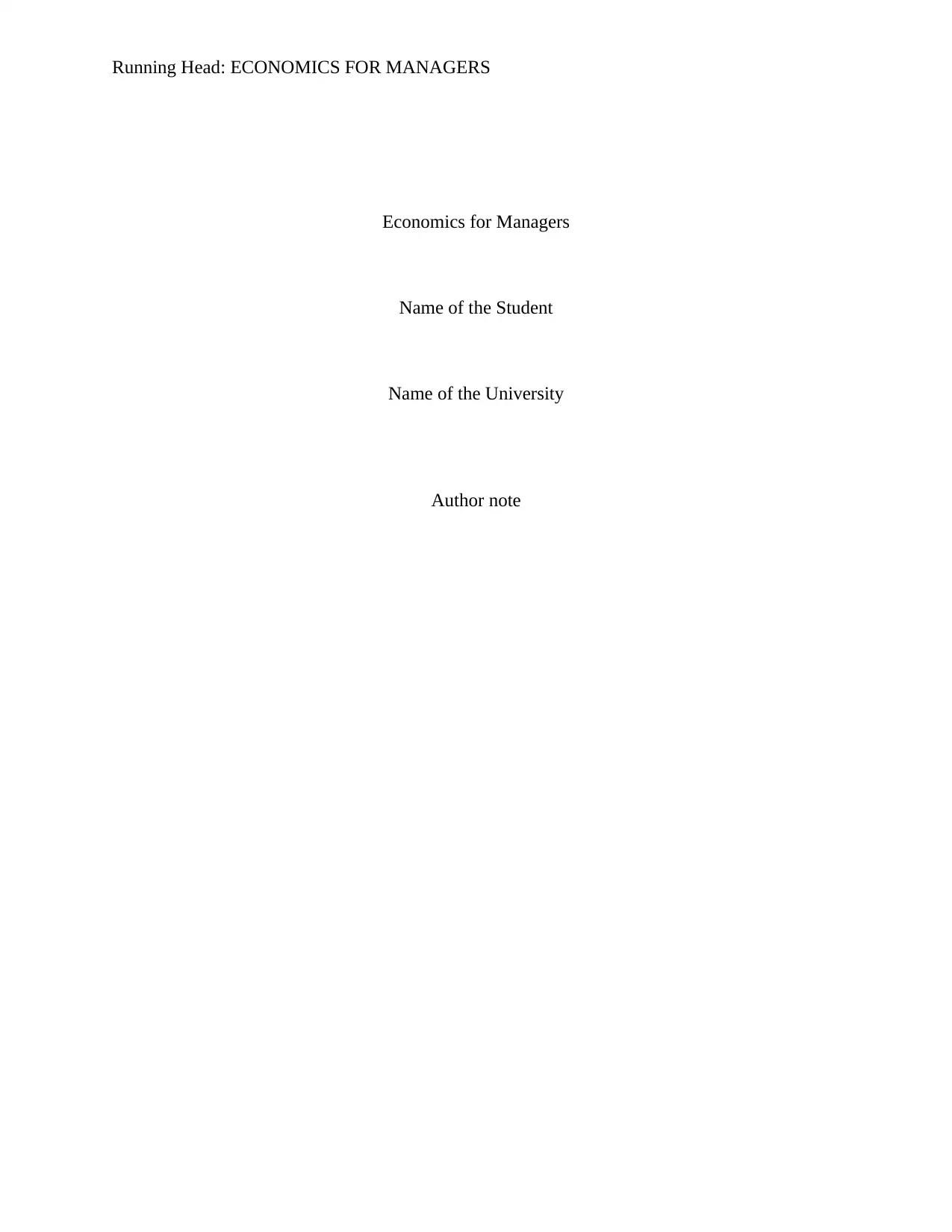
Running Head: ECONOMICS FOR MANAGERS
Economics for Managers
Name of the Student
Name of the University
Author note
Economics for Managers
Name of the Student
Name of the University
Author note
Paraphrase This Document
Need a fresh take? Get an instant paraphrase of this document with our AI Paraphraser
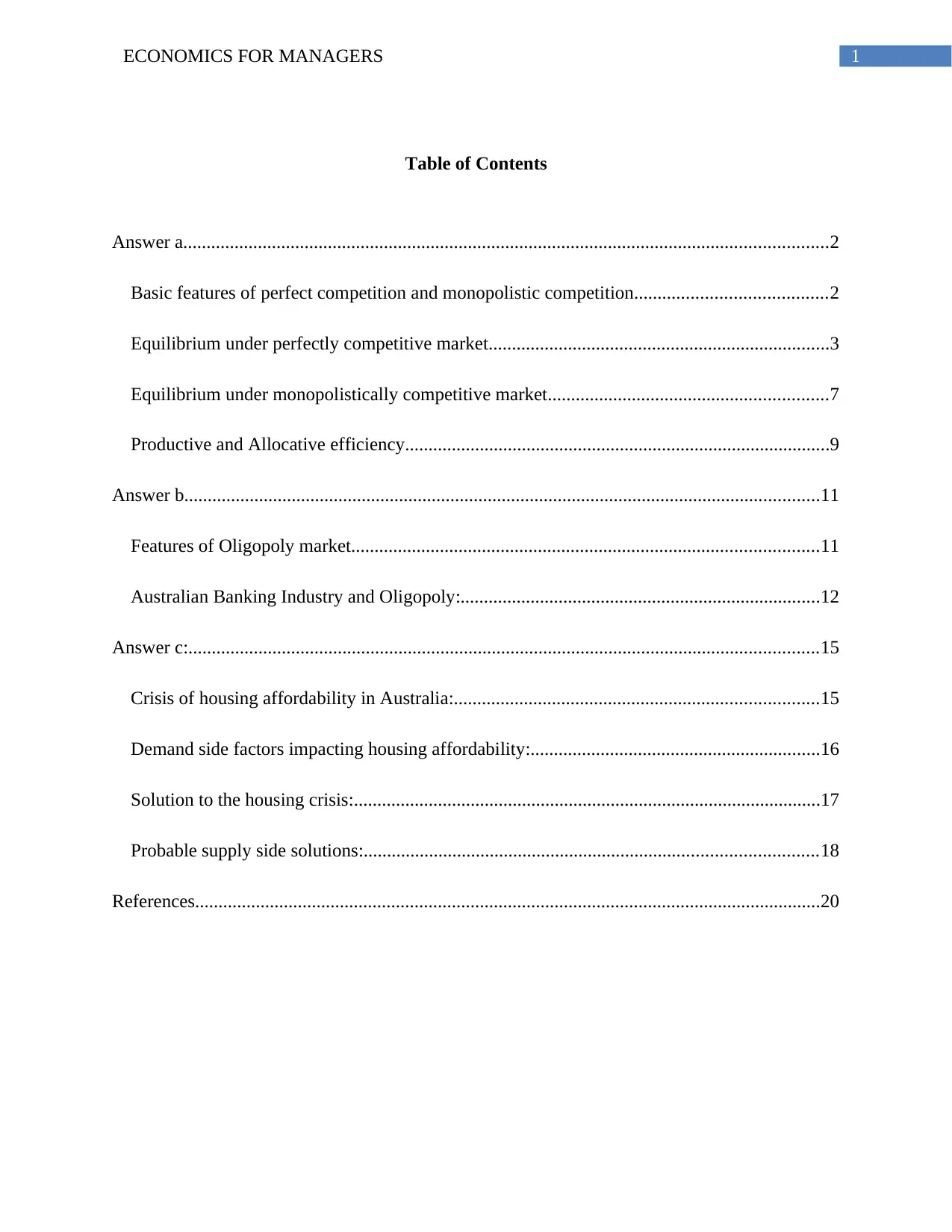
1ECONOMICS FOR MANAGERS
Table of Contents
Answer a..........................................................................................................................................2
Basic features of perfect competition and monopolistic competition.........................................2
Equilibrium under perfectly competitive market.........................................................................3
Equilibrium under monopolistically competitive market............................................................7
Productive and Allocative efficiency...........................................................................................9
Answer b........................................................................................................................................11
Features of Oligopoly market....................................................................................................11
Australian Banking Industry and Oligopoly:.............................................................................12
Answer c:.......................................................................................................................................15
Crisis of housing affordability in Australia:..............................................................................15
Demand side factors impacting housing affordability:..............................................................16
Solution to the housing crisis:....................................................................................................17
Probable supply side solutions:.................................................................................................18
References......................................................................................................................................20
Table of Contents
Answer a..........................................................................................................................................2
Basic features of perfect competition and monopolistic competition.........................................2
Equilibrium under perfectly competitive market.........................................................................3
Equilibrium under monopolistically competitive market............................................................7
Productive and Allocative efficiency...........................................................................................9
Answer b........................................................................................................................................11
Features of Oligopoly market....................................................................................................11
Australian Banking Industry and Oligopoly:.............................................................................12
Answer c:.......................................................................................................................................15
Crisis of housing affordability in Australia:..............................................................................15
Demand side factors impacting housing affordability:..............................................................16
Solution to the housing crisis:....................................................................................................17
Probable supply side solutions:.................................................................................................18
References......................................................................................................................................20
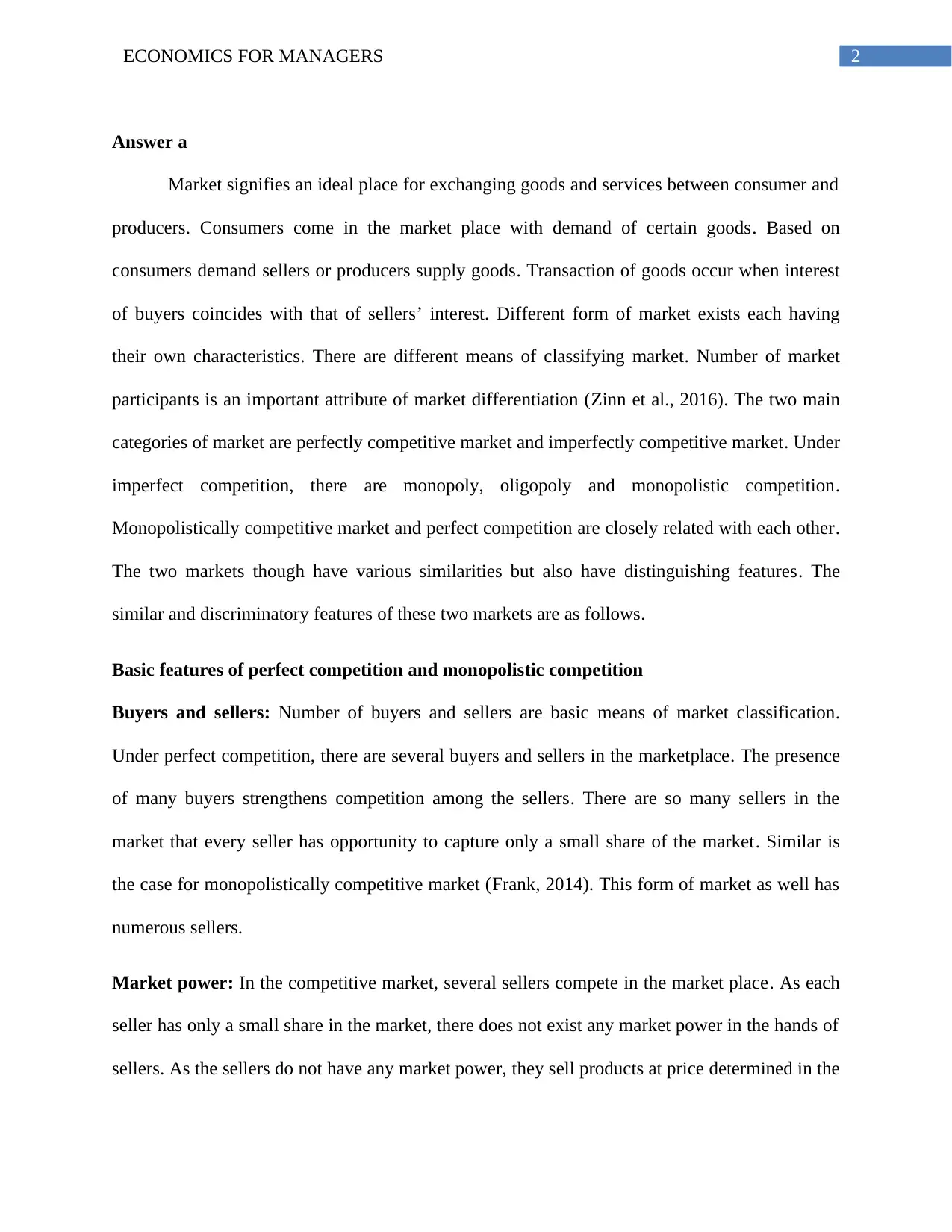
2ECONOMICS FOR MANAGERS
Answer a
Market signifies an ideal place for exchanging goods and services between consumer and
producers. Consumers come in the market place with demand of certain goods. Based on
consumers demand sellers or producers supply goods. Transaction of goods occur when interest
of buyers coincides with that of sellers’ interest. Different form of market exists each having
their own characteristics. There are different means of classifying market. Number of market
participants is an important attribute of market differentiation (Zinn et al., 2016). The two main
categories of market are perfectly competitive market and imperfectly competitive market. Under
imperfect competition, there are monopoly, oligopoly and monopolistic competition.
Monopolistically competitive market and perfect competition are closely related with each other.
The two markets though have various similarities but also have distinguishing features. The
similar and discriminatory features of these two markets are as follows.
Basic features of perfect competition and monopolistic competition
Buyers and sellers: Number of buyers and sellers are basic means of market classification.
Under perfect competition, there are several buyers and sellers in the marketplace. The presence
of many buyers strengthens competition among the sellers. There are so many sellers in the
market that every seller has opportunity to capture only a small share of the market. Similar is
the case for monopolistically competitive market (Frank, 2014). This form of market as well has
numerous sellers.
Market power: In the competitive market, several sellers compete in the market place. As each
seller has only a small share in the market, there does not exist any market power in the hands of
sellers. As the sellers do not have any market power, they sell products at price determined in the
Answer a
Market signifies an ideal place for exchanging goods and services between consumer and
producers. Consumers come in the market place with demand of certain goods. Based on
consumers demand sellers or producers supply goods. Transaction of goods occur when interest
of buyers coincides with that of sellers’ interest. Different form of market exists each having
their own characteristics. There are different means of classifying market. Number of market
participants is an important attribute of market differentiation (Zinn et al., 2016). The two main
categories of market are perfectly competitive market and imperfectly competitive market. Under
imperfect competition, there are monopoly, oligopoly and monopolistic competition.
Monopolistically competitive market and perfect competition are closely related with each other.
The two markets though have various similarities but also have distinguishing features. The
similar and discriminatory features of these two markets are as follows.
Basic features of perfect competition and monopolistic competition
Buyers and sellers: Number of buyers and sellers are basic means of market classification.
Under perfect competition, there are several buyers and sellers in the marketplace. The presence
of many buyers strengthens competition among the sellers. There are so many sellers in the
market that every seller has opportunity to capture only a small share of the market. Similar is
the case for monopolistically competitive market (Frank, 2014). This form of market as well has
numerous sellers.
Market power: In the competitive market, several sellers compete in the market place. As each
seller has only a small share in the market, there does not exist any market power in the hands of
sellers. As the sellers do not have any market power, they sell products at price determined in the
⊘ This is a preview!⊘
Do you want full access?
Subscribe today to unlock all pages.

Trusted by 1+ million students worldwide
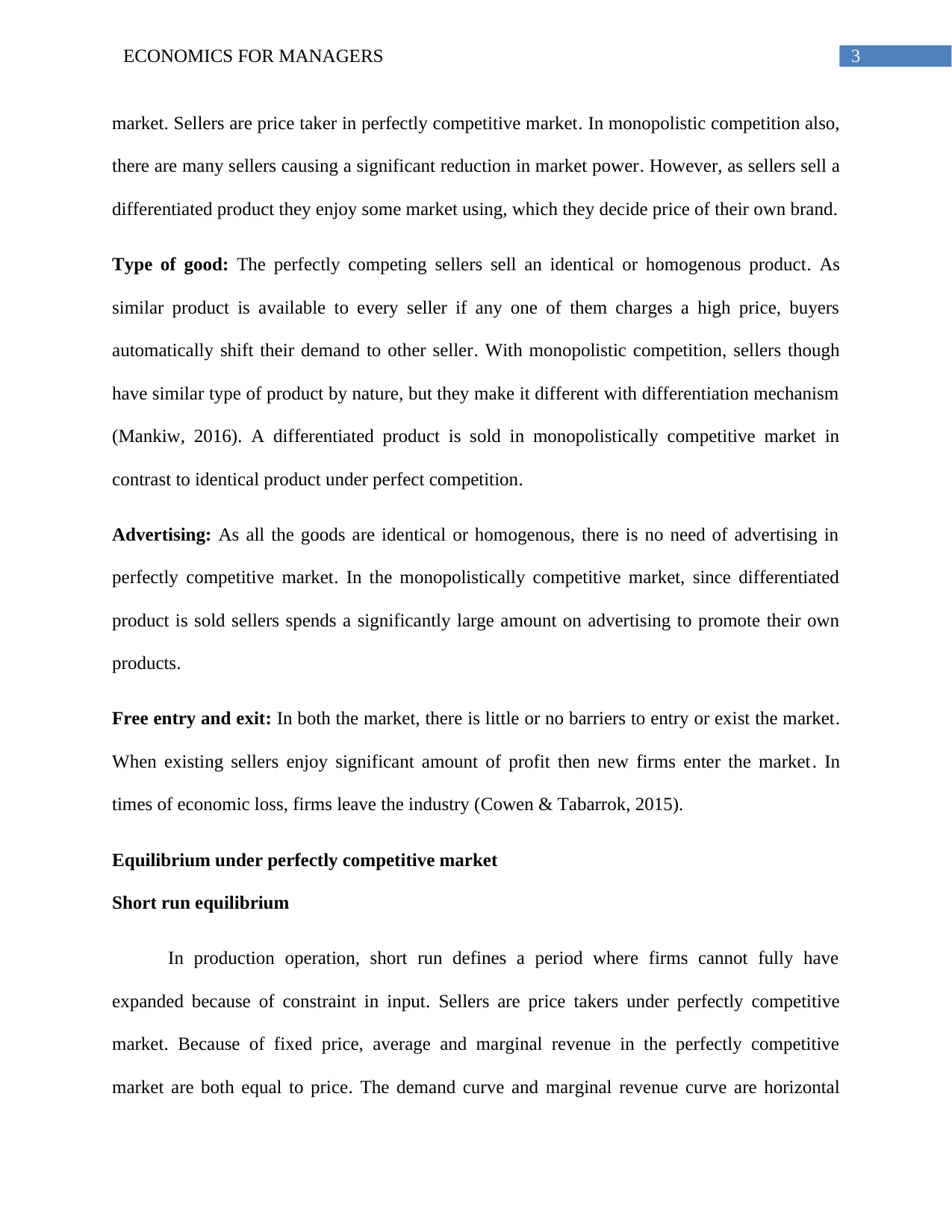
3ECONOMICS FOR MANAGERS
market. Sellers are price taker in perfectly competitive market. In monopolistic competition also,
there are many sellers causing a significant reduction in market power. However, as sellers sell a
differentiated product they enjoy some market using, which they decide price of their own brand.
Type of good: The perfectly competing sellers sell an identical or homogenous product. As
similar product is available to every seller if any one of them charges a high price, buyers
automatically shift their demand to other seller. With monopolistic competition, sellers though
have similar type of product by nature, but they make it different with differentiation mechanism
(Mankiw, 2016). A differentiated product is sold in monopolistically competitive market in
contrast to identical product under perfect competition.
Advertising: As all the goods are identical or homogenous, there is no need of advertising in
perfectly competitive market. In the monopolistically competitive market, since differentiated
product is sold sellers spends a significantly large amount on advertising to promote their own
products.
Free entry and exit: In both the market, there is little or no barriers to entry or exist the market.
When existing sellers enjoy significant amount of profit then new firms enter the market. In
times of economic loss, firms leave the industry (Cowen & Tabarrok, 2015).
Equilibrium under perfectly competitive market
Short run equilibrium
In production operation, short run defines a period where firms cannot fully have
expanded because of constraint in input. Sellers are price takers under perfectly competitive
market. Because of fixed price, average and marginal revenue in the perfectly competitive
market are both equal to price. The demand curve and marginal revenue curve are horizontal
market. Sellers are price taker in perfectly competitive market. In monopolistic competition also,
there are many sellers causing a significant reduction in market power. However, as sellers sell a
differentiated product they enjoy some market using, which they decide price of their own brand.
Type of good: The perfectly competing sellers sell an identical or homogenous product. As
similar product is available to every seller if any one of them charges a high price, buyers
automatically shift their demand to other seller. With monopolistic competition, sellers though
have similar type of product by nature, but they make it different with differentiation mechanism
(Mankiw, 2016). A differentiated product is sold in monopolistically competitive market in
contrast to identical product under perfect competition.
Advertising: As all the goods are identical or homogenous, there is no need of advertising in
perfectly competitive market. In the monopolistically competitive market, since differentiated
product is sold sellers spends a significantly large amount on advertising to promote their own
products.
Free entry and exit: In both the market, there is little or no barriers to entry or exist the market.
When existing sellers enjoy significant amount of profit then new firms enter the market. In
times of economic loss, firms leave the industry (Cowen & Tabarrok, 2015).
Equilibrium under perfectly competitive market
Short run equilibrium
In production operation, short run defines a period where firms cannot fully have
expanded because of constraint in input. Sellers are price takers under perfectly competitive
market. Because of fixed price, average and marginal revenue in the perfectly competitive
market are both equal to price. The demand curve and marginal revenue curve are horizontal
Paraphrase This Document
Need a fresh take? Get an instant paraphrase of this document with our AI Paraphraser
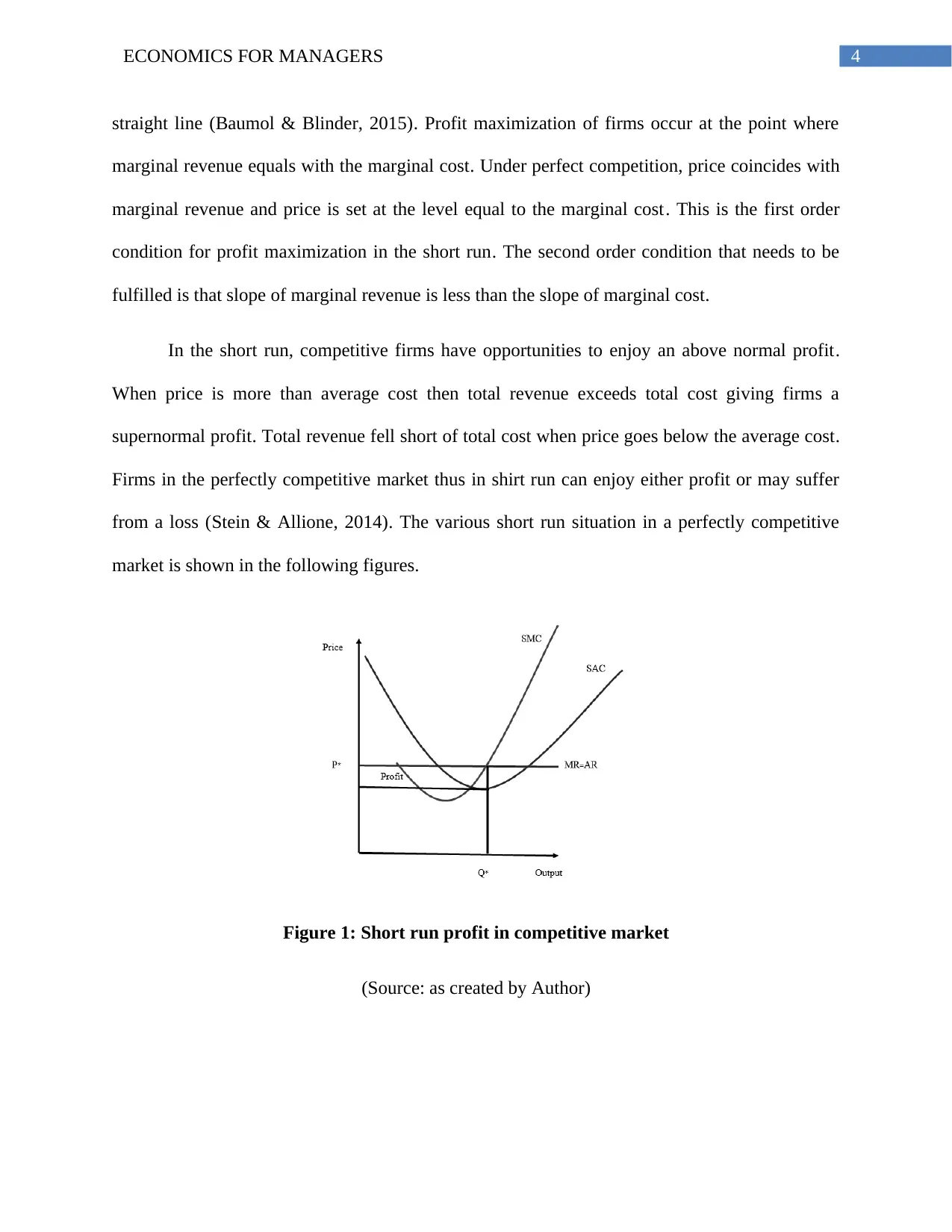
4ECONOMICS FOR MANAGERS
straight line (Baumol & Blinder, 2015). Profit maximization of firms occur at the point where
marginal revenue equals with the marginal cost. Under perfect competition, price coincides with
marginal revenue and price is set at the level equal to the marginal cost. This is the first order
condition for profit maximization in the short run. The second order condition that needs to be
fulfilled is that slope of marginal revenue is less than the slope of marginal cost.
In the short run, competitive firms have opportunities to enjoy an above normal profit.
When price is more than average cost then total revenue exceeds total cost giving firms a
supernormal profit. Total revenue fell short of total cost when price goes below the average cost.
Firms in the perfectly competitive market thus in shirt run can enjoy either profit or may suffer
from a loss (Stein & Allione, 2014). The various short run situation in a perfectly competitive
market is shown in the following figures.
Figure 1: Short run profit in competitive market
(Source: as created by Author)
straight line (Baumol & Blinder, 2015). Profit maximization of firms occur at the point where
marginal revenue equals with the marginal cost. Under perfect competition, price coincides with
marginal revenue and price is set at the level equal to the marginal cost. This is the first order
condition for profit maximization in the short run. The second order condition that needs to be
fulfilled is that slope of marginal revenue is less than the slope of marginal cost.
In the short run, competitive firms have opportunities to enjoy an above normal profit.
When price is more than average cost then total revenue exceeds total cost giving firms a
supernormal profit. Total revenue fell short of total cost when price goes below the average cost.
Firms in the perfectly competitive market thus in shirt run can enjoy either profit or may suffer
from a loss (Stein & Allione, 2014). The various short run situation in a perfectly competitive
market is shown in the following figures.
Figure 1: Short run profit in competitive market
(Source: as created by Author)
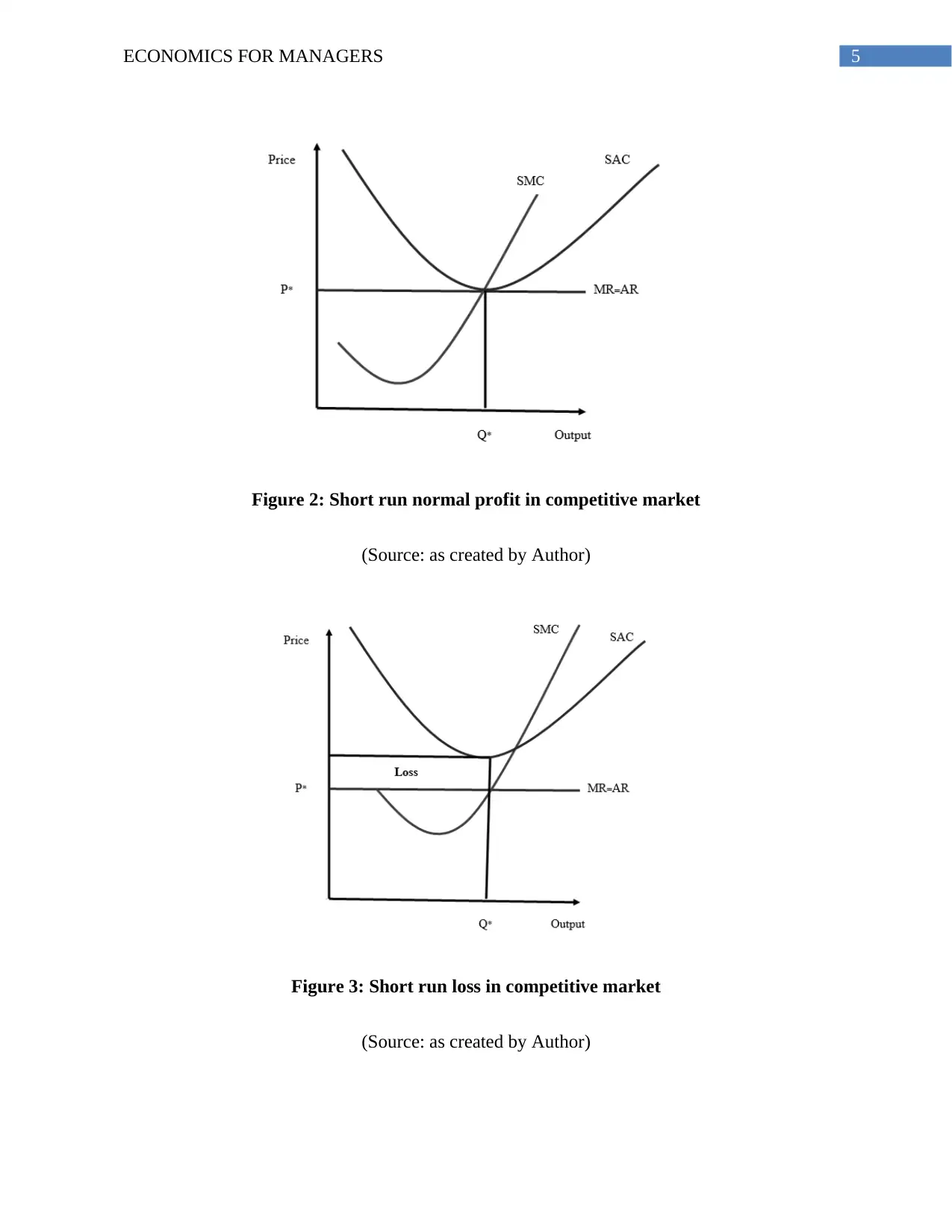
5ECONOMICS FOR MANAGERS
Figure 2: Short run normal profit in competitive market
(Source: as created by Author)
Figure 3: Short run loss in competitive market
(Source: as created by Author)
Figure 2: Short run normal profit in competitive market
(Source: as created by Author)
Figure 3: Short run loss in competitive market
(Source: as created by Author)
⊘ This is a preview!⊘
Do you want full access?
Subscribe today to unlock all pages.

Trusted by 1+ million students worldwide
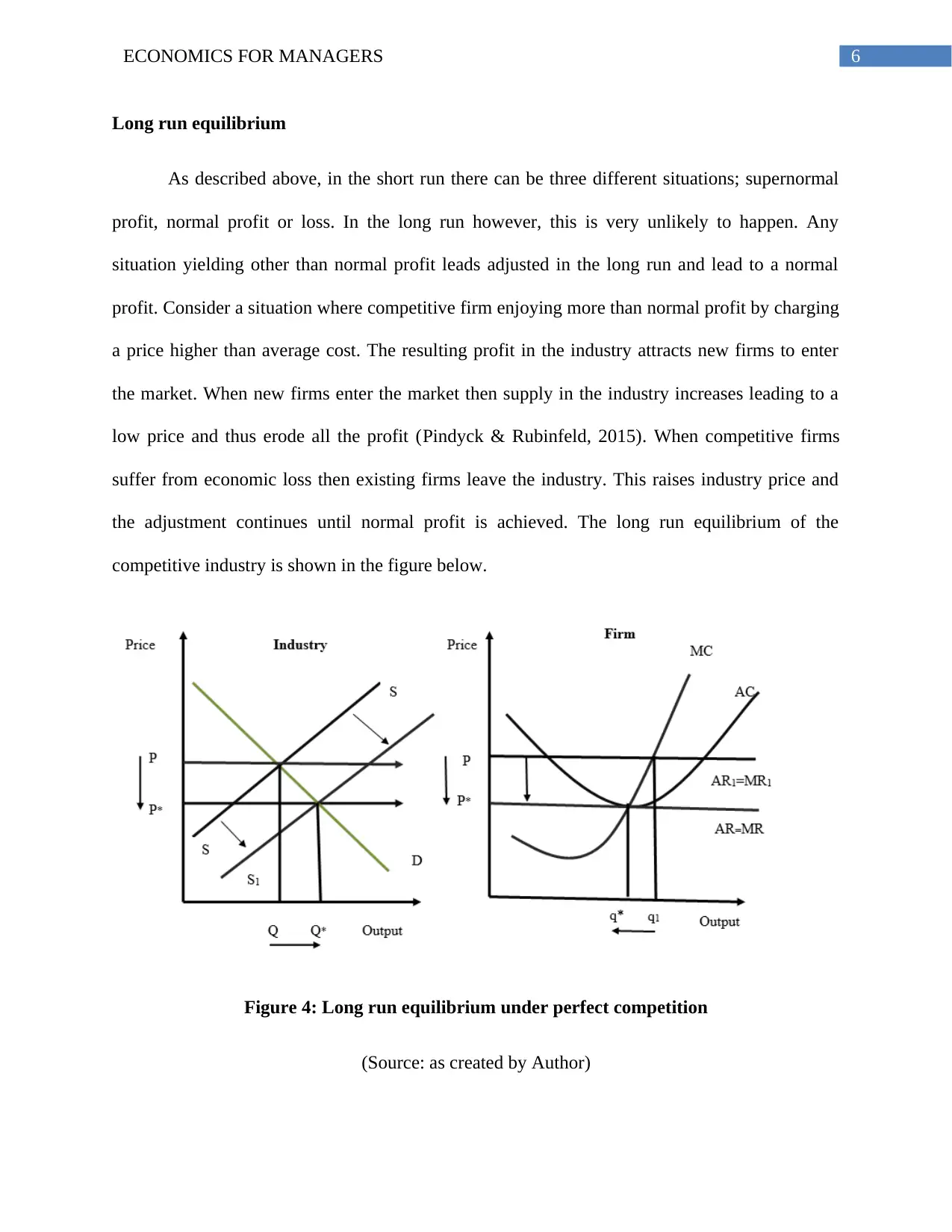
6ECONOMICS FOR MANAGERS
Long run equilibrium
As described above, in the short run there can be three different situations; supernormal
profit, normal profit or loss. In the long run however, this is very unlikely to happen. Any
situation yielding other than normal profit leads adjusted in the long run and lead to a normal
profit. Consider a situation where competitive firm enjoying more than normal profit by charging
a price higher than average cost. The resulting profit in the industry attracts new firms to enter
the market. When new firms enter the market then supply in the industry increases leading to a
low price and thus erode all the profit (Pindyck & Rubinfeld, 2015). When competitive firms
suffer from economic loss then existing firms leave the industry. This raises industry price and
the adjustment continues until normal profit is achieved. The long run equilibrium of the
competitive industry is shown in the figure below.
Figure 4: Long run equilibrium under perfect competition
(Source: as created by Author)
Long run equilibrium
As described above, in the short run there can be three different situations; supernormal
profit, normal profit or loss. In the long run however, this is very unlikely to happen. Any
situation yielding other than normal profit leads adjusted in the long run and lead to a normal
profit. Consider a situation where competitive firm enjoying more than normal profit by charging
a price higher than average cost. The resulting profit in the industry attracts new firms to enter
the market. When new firms enter the market then supply in the industry increases leading to a
low price and thus erode all the profit (Pindyck & Rubinfeld, 2015). When competitive firms
suffer from economic loss then existing firms leave the industry. This raises industry price and
the adjustment continues until normal profit is achieved. The long run equilibrium of the
competitive industry is shown in the figure below.
Figure 4: Long run equilibrium under perfect competition
(Source: as created by Author)
Paraphrase This Document
Need a fresh take? Get an instant paraphrase of this document with our AI Paraphraser
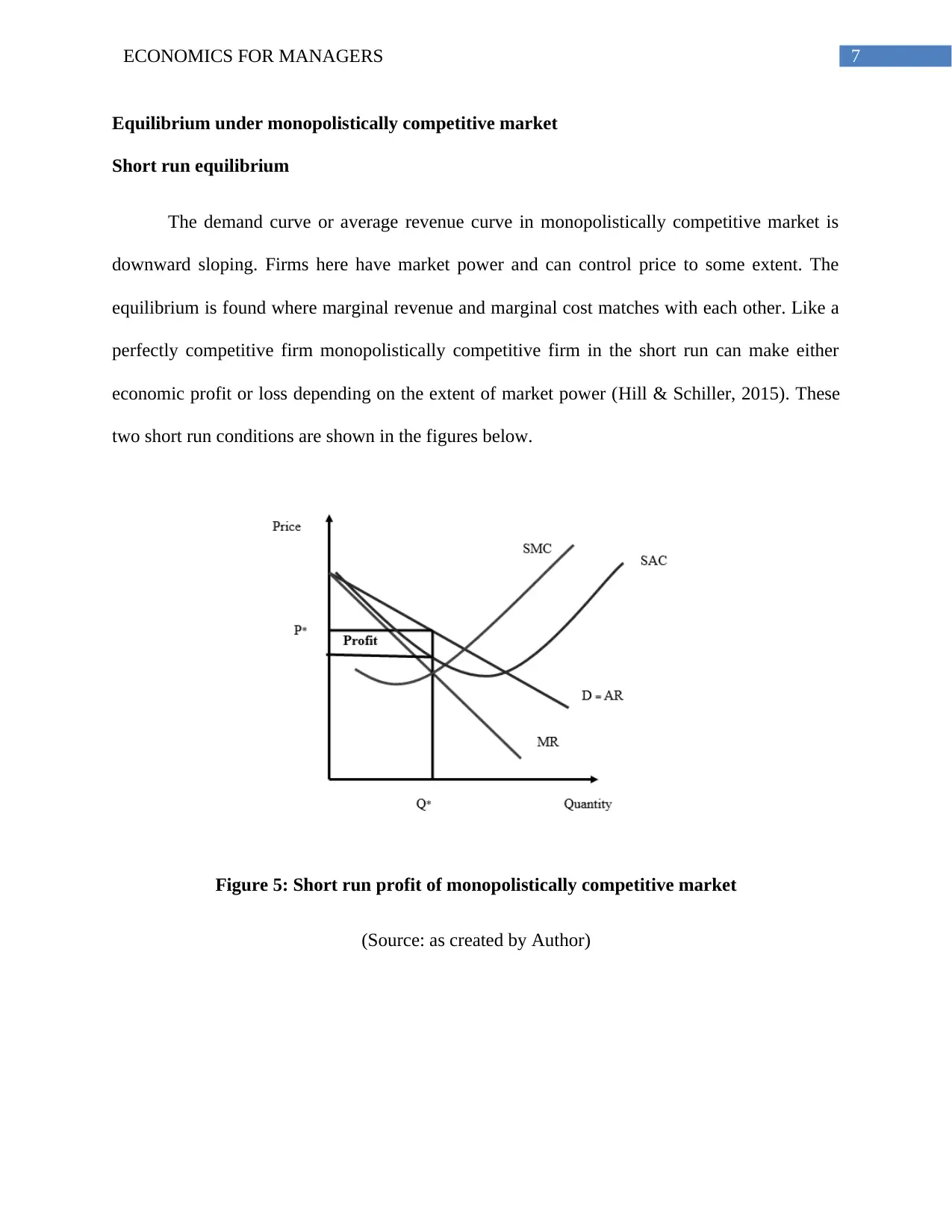
7ECONOMICS FOR MANAGERS
Equilibrium under monopolistically competitive market
Short run equilibrium
The demand curve or average revenue curve in monopolistically competitive market is
downward sloping. Firms here have market power and can control price to some extent. The
equilibrium is found where marginal revenue and marginal cost matches with each other. Like a
perfectly competitive firm monopolistically competitive firm in the short run can make either
economic profit or loss depending on the extent of market power (Hill & Schiller, 2015). These
two short run conditions are shown in the figures below.
Figure 5: Short run profit of monopolistically competitive market
(Source: as created by Author)
Equilibrium under monopolistically competitive market
Short run equilibrium
The demand curve or average revenue curve in monopolistically competitive market is
downward sloping. Firms here have market power and can control price to some extent. The
equilibrium is found where marginal revenue and marginal cost matches with each other. Like a
perfectly competitive firm monopolistically competitive firm in the short run can make either
economic profit or loss depending on the extent of market power (Hill & Schiller, 2015). These
two short run conditions are shown in the figures below.
Figure 5: Short run profit of monopolistically competitive market
(Source: as created by Author)
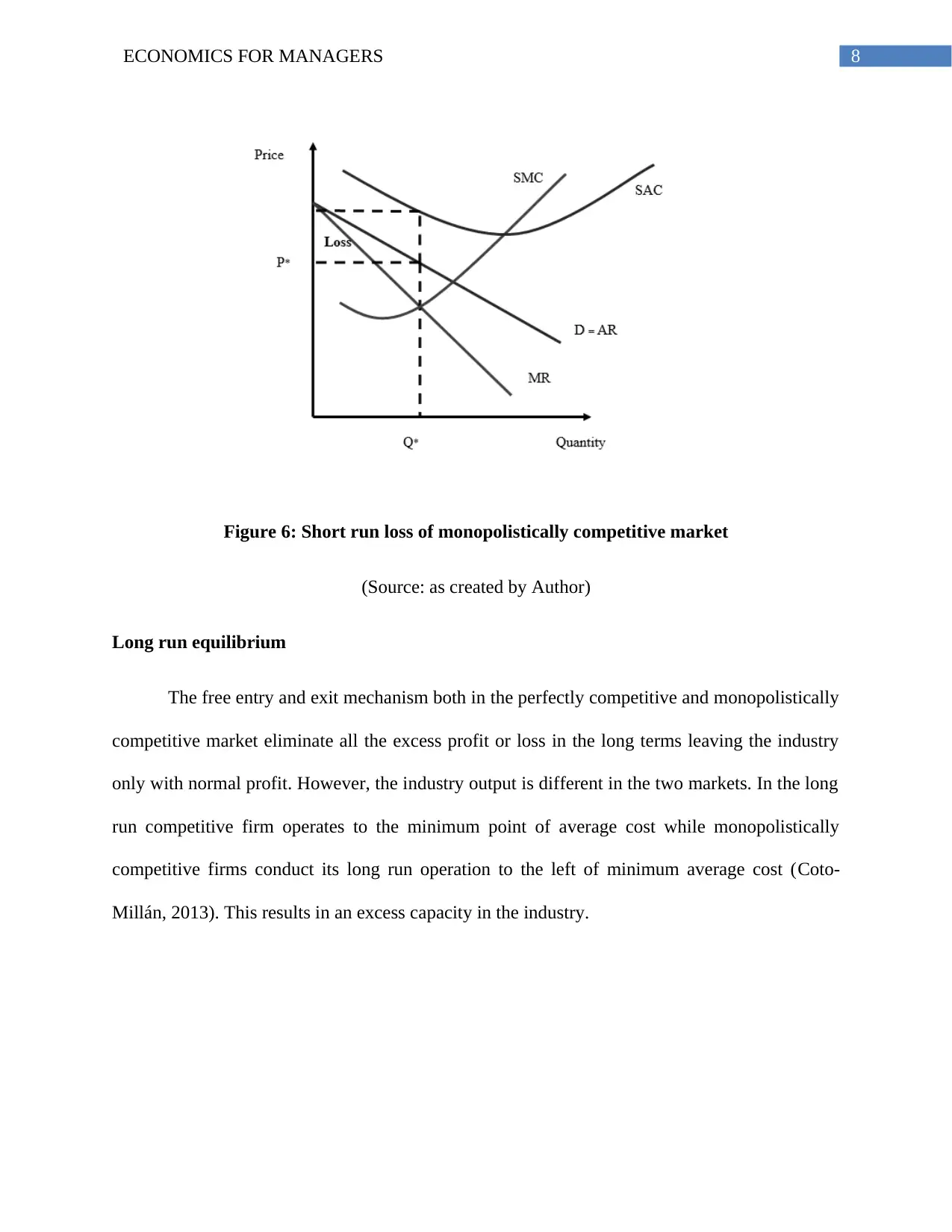
8ECONOMICS FOR MANAGERS
Figure 6: Short run loss of monopolistically competitive market
(Source: as created by Author)
Long run equilibrium
The free entry and exit mechanism both in the perfectly competitive and monopolistically
competitive market eliminate all the excess profit or loss in the long terms leaving the industry
only with normal profit. However, the industry output is different in the two markets. In the long
run competitive firm operates to the minimum point of average cost while monopolistically
competitive firms conduct its long run operation to the left of minimum average cost (Coto-
Millán, 2013). This results in an excess capacity in the industry.
Figure 6: Short run loss of monopolistically competitive market
(Source: as created by Author)
Long run equilibrium
The free entry and exit mechanism both in the perfectly competitive and monopolistically
competitive market eliminate all the excess profit or loss in the long terms leaving the industry
only with normal profit. However, the industry output is different in the two markets. In the long
run competitive firm operates to the minimum point of average cost while monopolistically
competitive firms conduct its long run operation to the left of minimum average cost (Coto-
Millán, 2013). This results in an excess capacity in the industry.
⊘ This is a preview!⊘
Do you want full access?
Subscribe today to unlock all pages.

Trusted by 1+ million students worldwide
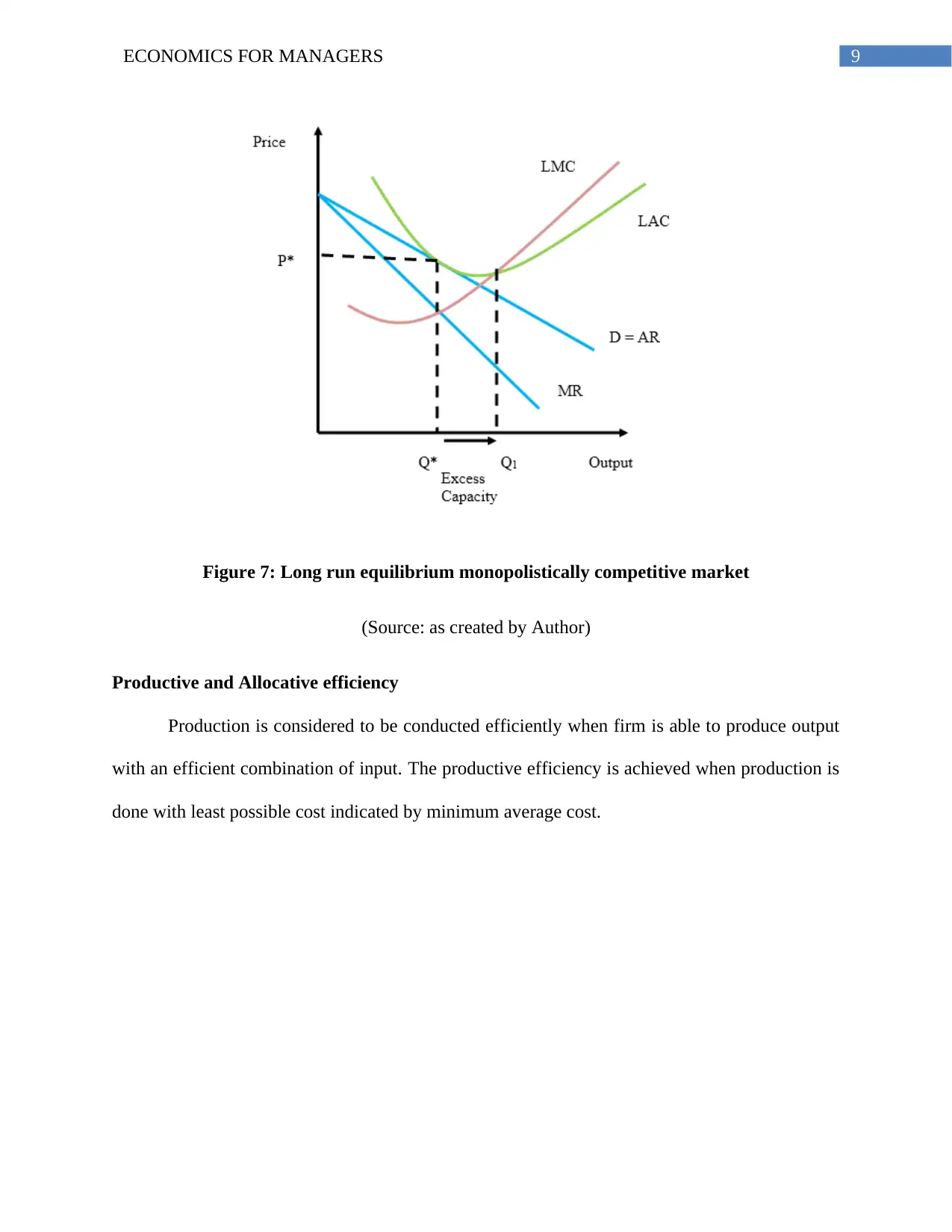
9ECONOMICS FOR MANAGERS
Figure 7: Long run equilibrium monopolistically competitive market
(Source: as created by Author)
Productive and Allocative efficiency
Production is considered to be conducted efficiently when firm is able to produce output
with an efficient combination of input. The productive efficiency is achieved when production is
done with least possible cost indicated by minimum average cost.
Figure 7: Long run equilibrium monopolistically competitive market
(Source: as created by Author)
Productive and Allocative efficiency
Production is considered to be conducted efficiently when firm is able to produce output
with an efficient combination of input. The productive efficiency is achieved when production is
done with least possible cost indicated by minimum average cost.
Paraphrase This Document
Need a fresh take? Get an instant paraphrase of this document with our AI Paraphraser
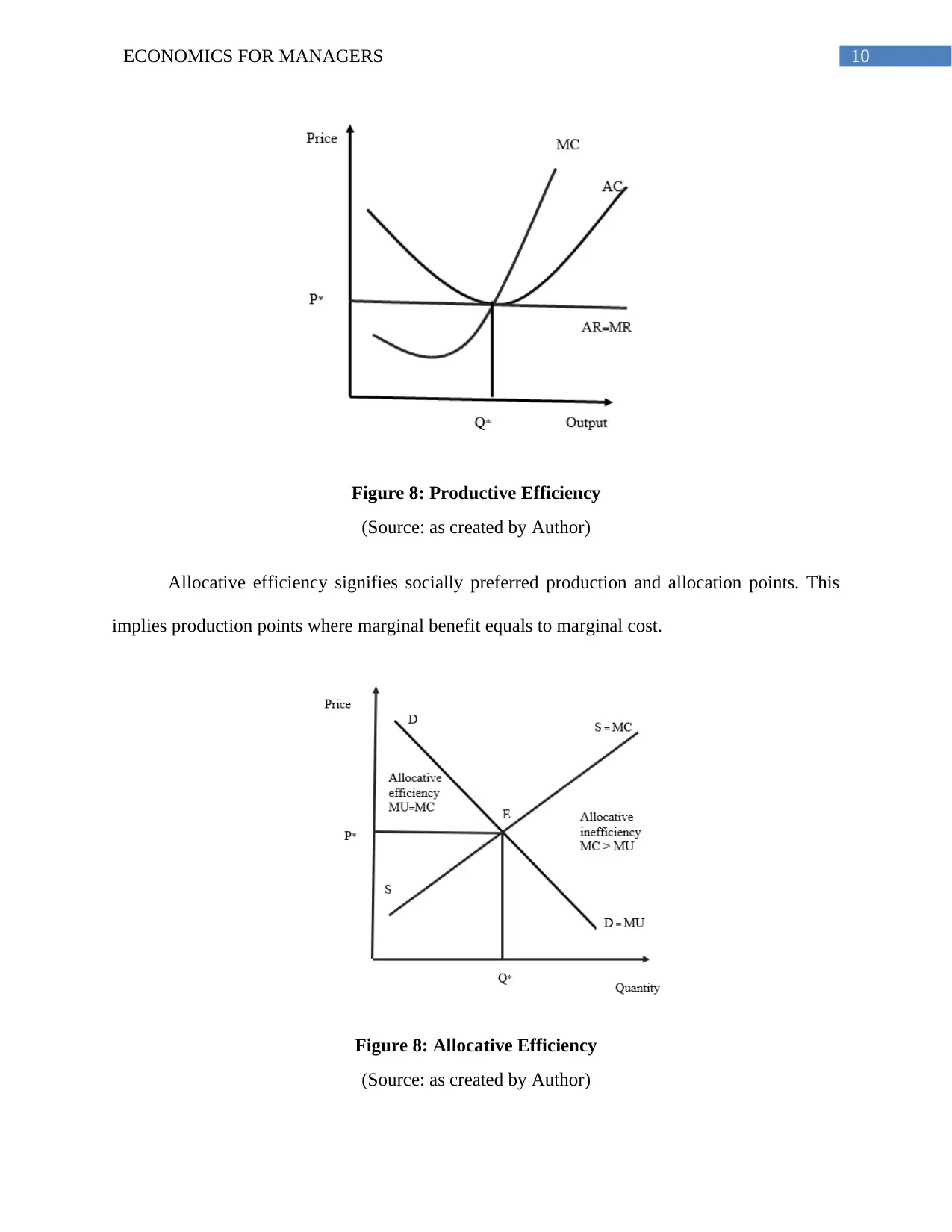
10ECONOMICS FOR MANAGERS
Figure 8: Productive Efficiency
(Source: as created by Author)
Allocative efficiency signifies socially preferred production and allocation points. This
implies production points where marginal benefit equals to marginal cost.
Figure 8: Allocative Efficiency
(Source: as created by Author)
Figure 8: Productive Efficiency
(Source: as created by Author)
Allocative efficiency signifies socially preferred production and allocation points. This
implies production points where marginal benefit equals to marginal cost.
Figure 8: Allocative Efficiency
(Source: as created by Author)
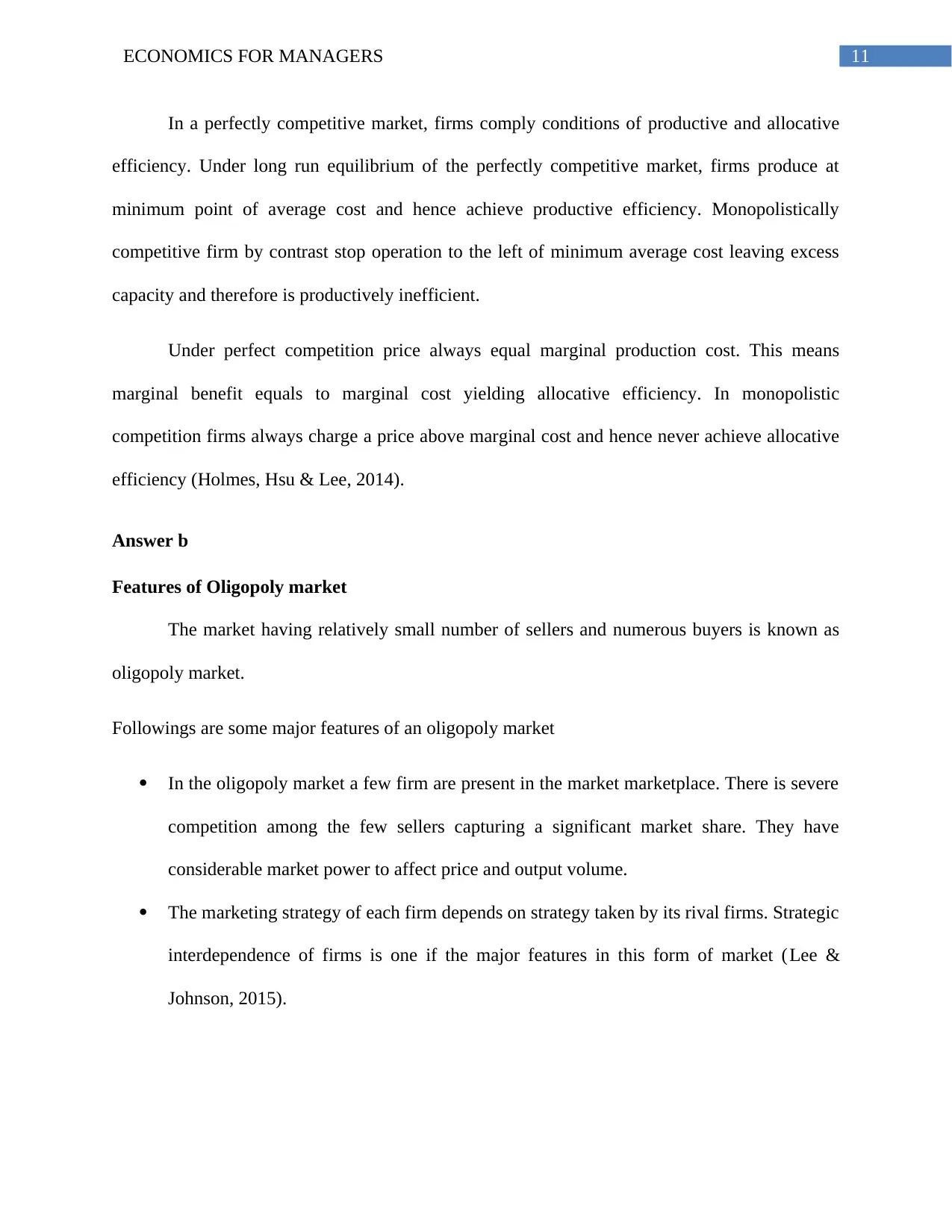
11ECONOMICS FOR MANAGERS
In a perfectly competitive market, firms comply conditions of productive and allocative
efficiency. Under long run equilibrium of the perfectly competitive market, firms produce at
minimum point of average cost and hence achieve productive efficiency. Monopolistically
competitive firm by contrast stop operation to the left of minimum average cost leaving excess
capacity and therefore is productively inefficient.
Under perfect competition price always equal marginal production cost. This means
marginal benefit equals to marginal cost yielding allocative efficiency. In monopolistic
competition firms always charge a price above marginal cost and hence never achieve allocative
efficiency (Holmes, Hsu & Lee, 2014).
Answer b
Features of Oligopoly market
The market having relatively small number of sellers and numerous buyers is known as
oligopoly market.
Followings are some major features of an oligopoly market
In the oligopoly market a few firm are present in the market marketplace. There is severe
competition among the few sellers capturing a significant market share. They have
considerable market power to affect price and output volume.
The marketing strategy of each firm depends on strategy taken by its rival firms. Strategic
interdependence of firms is one if the major features in this form of market (Lee &
Johnson, 2015).
In a perfectly competitive market, firms comply conditions of productive and allocative
efficiency. Under long run equilibrium of the perfectly competitive market, firms produce at
minimum point of average cost and hence achieve productive efficiency. Monopolistically
competitive firm by contrast stop operation to the left of minimum average cost leaving excess
capacity and therefore is productively inefficient.
Under perfect competition price always equal marginal production cost. This means
marginal benefit equals to marginal cost yielding allocative efficiency. In monopolistic
competition firms always charge a price above marginal cost and hence never achieve allocative
efficiency (Holmes, Hsu & Lee, 2014).
Answer b
Features of Oligopoly market
The market having relatively small number of sellers and numerous buyers is known as
oligopoly market.
Followings are some major features of an oligopoly market
In the oligopoly market a few firm are present in the market marketplace. There is severe
competition among the few sellers capturing a significant market share. They have
considerable market power to affect price and output volume.
The marketing strategy of each firm depends on strategy taken by its rival firms. Strategic
interdependence of firms is one if the major features in this form of market (Lee &
Johnson, 2015).
⊘ This is a preview!⊘
Do you want full access?
Subscribe today to unlock all pages.

Trusted by 1+ million students worldwide
1 out of 23
Related Documents
Your All-in-One AI-Powered Toolkit for Academic Success.
+13062052269
info@desklib.com
Available 24*7 on WhatsApp / Email
![[object Object]](/_next/static/media/star-bottom.7253800d.svg)
Unlock your academic potential
Copyright © 2020–2025 A2Z Services. All Rights Reserved. Developed and managed by ZUCOL.





